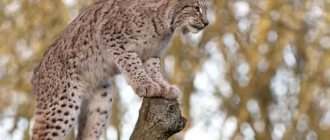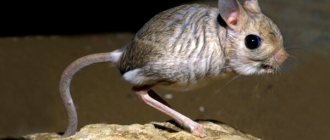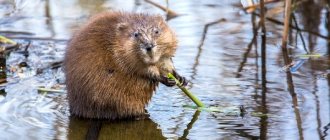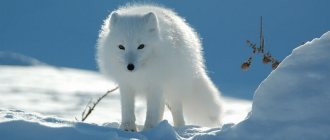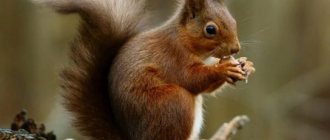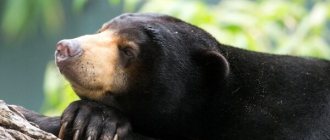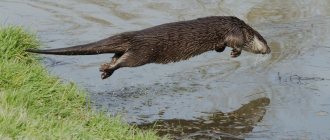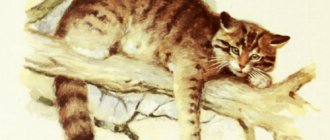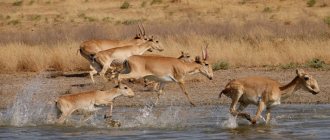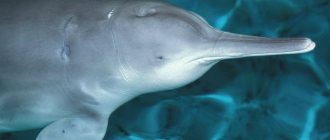photo 1 837
The wolverine (Gulo gulo) is listed in the Red Books of the Leningrad Region, Murmansk Region, Nizhny Novgorod Region, Omsk Region, the Republic of Karelia and the Udmurt Republic.
The Red Book contains all the necessary information about rare species of animals and measures for their protection. Read a detailed description and features of the Wolverine species »»
Leningrad region
Status: III category. Rare, locally widespread, vulnerable species.
Spreading
In the Leningrad region, traces of the presence of wolverines are more often found in the north of the Karelian Isthmus and in the northeastern regions.
Number
Traces of wolverine in the forests of the Leningrad region are quite rare. It is known that in the 1960–70s. at least 6–8 of these predators lived in the Volkhov, Priozersk, Vsevolozhsk and Vyborg regions. The wolverine is still found in approximately the same places today. So, in the 2002/2003 season. Wolverine tracks were recorded in the Priozersky, Vyborg, Boksitogorsk and Tikhvin regions. It is periodically observed on the Kurgal Peninsula (Kingisepp district), where it enters from Finland in winter across the ice of the bay. In 2005–2010 its traces were observed on the territory of the Nizhne-Svirsky Nature Reserve, and in 2014–2015. the animal constantly stayed in the territory of the planned Karelian Forest protected area. The total number of predators in the Leningrad region in recent years is estimated at approximately 7–10 individuals.
Source: Red Book of Nature of the Leningrad Region. Volume 3. Animals. Ed. Noskov G.A., Gaginskaya A.R. et al. (2002) St. Petersburg
Interesting information
There are many interesting facts associated with this animal:
- Sometimes the wolverine is called a "skunk bear." The animal received this name due to the work of the anal glands, which secrete a foul-smelling yellowish secretion. The wolverine uses it to mark its territory and scare away other predators;
- this animal can not only move through deep snow, but also climb trees and swim;
- during hunting, the animal can reach speeds of up to 48 km/h;
- the wolverine makes sounds similar to the yelping of a fox;
- female animals can prevent the development of the fetus if they do not have enough resources to bear and feed their offspring;
- the appearance of the chest is unique for each individual;
- The animal's activity during the day is only 3-4 hours. The rest of the time he sleeps;
- A wolverine raised in captivity is absolutely non-aggressive and gets used to humans.
Murmansk region
Status: V category. Regenerating appearance.
Spreading
Wolverine is widespread in the Murmansk region, but is more often found in the habitats of wild and domestic deer.
Number
On the Kola Peninsula, the wolverine was quite numerous until the 60s. XX century. Its number, according to the Game Management Department, reached 500 individuals; before 1975, 20–30 skins were received annually. The maximum was recorded in 1956, when 93 skins were handed over. By the 80s. the livestock decreased sharply and amounted to about 200 heads. Since 1986, fishing has been prohibited. But the number continued to decline, and in the early 90s. in the Murmansk region there were barely 100 individuals. The number of wolverines has not decreased in recent years.
Source: Red Book of the Murmansk Region. Ed. Asming S.V., Berlina N.G., Belkina O.A., Bianki V.V., Bobrov A.A., Boyko N.S., Borovichev E.A., Vorobyova E.G. (2014)
External features of the view
The appearance of the animal is very specific. Wolverine resembles a badger, a dog and a bear cub at the same time. It is characterized by badger hair and an elongated muzzle with small eyes and ears, a dog's nose, tail and grin, bear claws, hunchback and clubfoot. This animal, like bears, lives in dens and when walking, it steps on its entire foot. This walking feature allows him to move even in deep snow.
Among all representatives of mustelids, the wolverine is one of the largest. The weight of females rarely exceeds 10 kg, and males can reach 20 kg. The animal's body length is approximately 1.2 meters, of which 18-25 cm is a fluffy tail. Fur color varies from black to brownish brown. The fur on the face and chest has a lighter shade.
The wolverine has very strong jaws and sharp teeth, which give the animal a terrifying appearance, allowing it to grind animal bones and feed on frozen carrion. The fur of this animal is very warm and provides it with such thermal insulation that in winter the snow does not melt under the wolverine.
Nizhny Novgorod Region
Status: II category. A rare species with a steadily declining population.
Spreading
In the Nizhny Novgorod region already in the first half of the 20th century. Only regular visits of single individuals to the northern regions were recorded. In 1872, wolverine was caught in the river basin. Kerzhenets (mouth of the Pugai River). After 1960, it was found in winter in the Krasnobakovsky district, observed in the summer in Varnavinsky, and in the winter in Vetluzhsky districts, and also, according to survey data, in the Sharangsky and Voskresensky districts; winter 2000-2001 traces were noted in the north of Shakhunsky and north-west of Vetluzhsky districts.
Number
The number is low throughout.
Source: Red Book of the Nizhny Novgorod Region. Volume 1. Animals. Ed. G.A. Anufriev (2014) Nizhny Novgorod: DECOM
Omsk region
Status: III category. Rare, locally widespread, vulnerable species.
Spreading
In the 1920s The animal was found in the basins of the Uy, Shish, Tui, Urna and Demyanka rivers. In the middle of the 20th century. wolverine was found in the upper reaches of the river. Malaya Bicha and in the region of the mouth of Ishim, on the left bank of the Irtysh. During the same period, the southern border of the predator’s distribution was drawn through Tara, and rare sightings of the wolverine were noted only in the southern taiga subzone. In 1995-2003. permanent residence of the wolverine was revealed only in six southern taiga and subtaiga administrative districts: Ust-Ishimsky, Tevrizsky, Tarsky, Sedelnikovsky, Znamensky and Bolsheukovsky. Single visits were noted in the Krutinsky and Muromtsevo districts. The southernmost meeting points of the animal along the right bank of the Irtysh were recorded in recent years (1998, 1999) in the vicinity of the village. Bakino Sedelnikovsky district. The southern border of the predator's regular visits to the aspen-birch forests on the right bank of the Omsk Irtysh region is approximately 10-15 km south of the river. Ouch. In some years, the wolverine enters the Kitlinsky swamp, but the river. Tara usually does not cross. The southernmost points of wolverine detection on the left bank of the Irtysh in recent years were identified in the Krutinsky district in 1990 in the reed thickets of Lake. Saltaim and in 1996 near the destroyed village. Sibirka. Thus, the predator sometimes reaches the level of the system of the largest lakes in the Omsk region: Tenis - Saltaim - Ik. The boundaries of the animal’s permanent visits to the left bank of the Irtysh are limited by the Tava and Bolshoi Aev rivers. The predator penetrates very rarely to the south of the vast Keeliny bog. It is well known that the wolverine is prone to long movements outside its permanent habitat. In the Omsk region. isolated cases of hunting animals were noted in such districts of the northern and central forest-steppe as Muromtsevo (1957, 1960, 1974), Tyukalinsky (1952, 1955), Krutinsky (1960), Sargatsky (1974) and even in the southern forest-steppe Okoneshnikovsky (1953, 1958).
Number
Absolute abundance of wolverine in winter periods of the 1950s–1980s. on the territory of the Omsk region. did not exceed 120 individuals. According to the winter route census data of 1995-2003, the number of animals changed accordingly: 32, 75, 24, 36, 87, 82, 51, 110, 57 individuals annually, averaging 62 individuals. Average long-term wolverine population density in 1994-2003. in taiga and subtaiga landscapes of the Omsk region. was 0.015 copies. for 10 sq. km. The configuration of the wolverine's range within the modern borders of the region remained unchanged throughout the 20th century, and winter numbers, apparently, never exceeded 120 individuals. This indicator corresponds to the maximum ecological capacity of biotopes for a predator.
Source: Red Book of the Omsk Region. Ed. G.N. Sidorov, N.V. Plikina (2015) Omsk: Or.UPY Publishing House
Wolverine and man
Hunters engaged in hunting in the taiga note that the animals caught are always distinguished by their fatness, although this predator is considered a rather rare trophy.
The skin of this animal is quite highly valued, since it has a long coat that does not turn frosty in the cold, and in severe frost. Therefore, wolverine fur is used for sewing outerwear, for making collars, hats, etc. Wolverine skin is more valuable than sable skin, so it can cost from 70 to 100 dollars.
Interesting information! A live animal is considered no less valuable, since it can cost around $250, although wolverine is difficult to find in captivity. This is due to the fact that the populations of this animal in nature are not so numerous.
It is worth noting one more feature: if wolverine cubs get to a person, they quickly become attached to him, becoming a tame animal. A domesticated animal behaves completely differently: the wolverine takes care of itself, does not require special conditions of detention, obeys its owner, but at the same time behaves very funny.
Udmurt republic
Status: I category. The species is on the verge of extinction.
Spreading
Within the species range, it inhabits a variety of biotopes, including valley forests and mountain tundras. It is especially characteristic of various types of dark coniferous and mountain taiga forests remote from populated areas.
Number
In the northern regions of Udmurtia, the wolverine remained constant until the 1930s. Subsequently, as a result of massive forest cuttings, the species' range shifted to the north. Currently, the wolverine’s permanent habitat is outside the borders of the republic. According to personal data and survey information, isolated encounters of nomadic animals are occasionally observed in the northern regions of Udmurtia.
Source: Red Book of the Udmurt Republic. Ed. O.G. Baranova, S.V. Dedyukhin, N.E. Zubtsovsky, V.V. Tuganaev, V.A. Tychinin, Yu.A. Tyulkin (2012) Cheboksary, “Perfectum”
Winner:
This battle is very interesting because the opponents are at the same time similar (both for the most part remained human), and at the same time have completely different advantages. Tony Stark can be very vulnerable in close combat - Wolverine's claws and ferocity can seriously damage the suit, and without it, Iron Man is not iron at all.
At the same time, at a distance and in the air, Tony is much stronger than Logan, because Wolverine can only cause real damage in close combat. Although, of course, his training allows him to skillfully handle various types of weapons. It is difficult to even imagine who will be the winner in such a clash.
Iron Man and Wolverine are good heroes, so I don't really want to see one of them defeated. However, it is your vote for your favorite that will help determine the winner.
Who do you think is stronger? A man with incredibly strong metal inside, or a man encased in an iron suit?
Now I bring to your attention a new selection of potentially dangerous little brothers.
How to escape from a wolverine
In a good way, since the wolverine is a predator, it should have been mentioned in the previous article on the topic, but... I confess, I was careless. “Just think, an overgrown ferret!” — flashed into my head after viewing the photo and studying general information about the little animal. I underestimated this “ferret”. Oh, how I underestimated.
However, first things first.
It should be said right away that the likelihood of meeting a wolverine in the wild is extremely low. Simply unimaginably small. So small that naturalists will consider it a great success. If you see it, you can consider this day historical and celebrate the memorable date every year.
Wolverine doesn’t know what fear is, but he knows what ferocity is. This does not mean that it attacks every living thing in sight. This means that if she attacks, she will be cruel, and if she decides to kill someone, she will go and kill.
The wolverine is small - about a meter in length, and its weight usually does not exceed thirty kilograms. But she is very brave, strong, dexterous, has bone-crushing teeth and huge claws. How strong and brave is this animal? Well, let's say, there are known cases when a wolverine personally killed an elk. She won't be afraid of a wolf either. And once in some zoo, they say, a wolverine, being put in the same enclosure with a polar bear, squeezed his throat, and he suffocated. You understand? This plump badger killed a polar bear!
There are very few cases of wolverine attacks on humans. This seems strange to me - judging by numerous descriptions, she should not be afraid of a person. But she has a very specific habit: climbing into houses, tents, hunting lodges and running the show there. She will break something, tear it, gnaw it, eat it, or take something to her if she considers the item useful in her personal household. He might also mark his home in secluded places, so the smell there will be unimaginable. It is useless to set traps on her - she is smart, cunning and careful, so she is unlikely to fall into them. So just do everything possible to prevent her from getting inside.
If the historical moment has come, and you meet wolverine, then... I don’t even know for sure what to do. But let's speculate. Wolverine attacks humans extremely rarely. It turns out that it makes sense to watch her, because the beast can easily go off about its business. If the animal shows interest and it seems to you that it is not at all friendly, then you can try to use the methods from the previous article: increase in size and make noise. But something tells me that this will not scare the wolverine, but will only cause bewilderment. She can also handle a dog easily. I would use fire against her - everyone should be afraid of its destructive power. Well, anyone who knows how to shoot wolverines with a gun has nothing to fear. Killing an animal, of course, is not the best solution, but not when it comes to life and death.
It can be assumed that the wolverine seeks to avoid meeting a person (it is not for nothing that such an event rarely happens). So it is likely that noisy behavior in the forest - various screams and clanging - will protect you from the risk of meeting with this devil in the flesh.
How to escape from a moose
This is a rather big animal - an adult elk can weigh up to 600 kilograms (and how does a wolverine cope with them?). Despite its impressive size, this is a completely peaceful inhabitant of the forest: it grazes itself, chewing bark and moss and looking down on others. But in some situations it can be dangerous. You should avoid meeting him during the rutting period (late summer - autumn), and also stay away from a female with cubs. In these cases, moose can behave aggressively and easily crush and trample the enemy. To prevent this from happening, use the already known method - be loud in the forest. If you encounter a moose, hide behind a tree and jingle something metal. The elk is blind - he will immediately lose sight of you, and an incomprehensible sound will alert the suspicious animal, and it will prefer to hide. You can, again, suddenly “increase” in front of the animal’s eyes.
Moose often come out onto the road. At the same time, it happens that they rush at the car, either in a fit of rage or fear. A sound signal or bright headlights in the dark can frighten them, so it is better not to honk at moose on the road. If you know that there is a high probability of encountering a moose on a particular section of the road, then take it especially seriously to comply with the speed limit and monitor what is happening along the way. By the way, even if you hit a moose by accident, and it is not your fault, you will still have to pay a fine (and a rather large one) either personally or to the insurance company (if you have insurance).
As a bonus - an entertaining and educational video:
How to escape from a wild boar
The forest boar is not your cute pocket pig. This is a terrible powerful beast weighing up to three centners, decorated with strong teeth that can easily rip open the stomach. They rarely attack humans. Exceptions: females with cubs (please stay away from ANY babies of ANY wild animals), injured or rabid animal. If you make noise, whistle, shout, rattle, a healthy childless boar will most likely leave. You can hide from him in a tree. There is no use in running - most likely he will catch up.
To save yourself from all these animals and prevent the sad consequences of meeting them, do not forget to prepare for a trip to the forest, following the recommendations that I gave in the article about predators.
In the section on the question of the Lord, hunters: which animal is more dangerous, a bear or a wolverine and why? given by the author Refracting light
The best answer is that the wolverine, due to its size, cannot be equal in danger to the bear. otherwise, in terms of her qualities of impudence, arrogance and dirty character, she is undoubtedly the most dirty creature in the taiga... but from our point of view, she probably doesn’t think so...
Reply from reed
[guru] person.
Answer from Lyudmila Kolosova
[guru] I once watched a film about a wolverine on TV and they said that it is more dangerous than a bear, since it is more daring, fearless and voracious.
Answer from Neuropathologist
[guru] the bear is more dangerous for humans, and the wolverine is more cunning than humans.
Reply from workable
[guru] Of course, I’m not a hunter, but I think that the wolverine is more dangerous. The bear is quite good-natured: only wounded animals, connecting rods or a mother bear with cubs are dangerous. And wolverine is very cunning and evil, and if she is caught by surprise (which happens very rarely), she becomes extremely dangerous.
Answer from Mike Vinkov
[guru] Bear, of course. Science does not know a single reliable case of a wolverine attacking a person.
Reply from Wolf
[guru] I wonder why wolverine is dangerous (it is as dangerous as a squirrel), but the bear is an unpredictable animal and also very strong.
